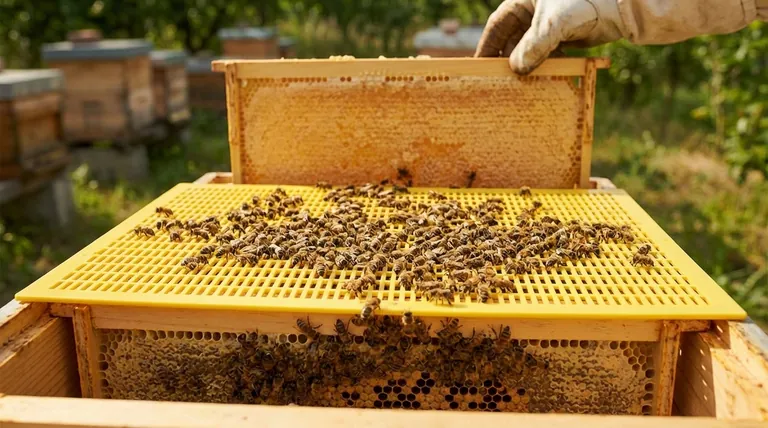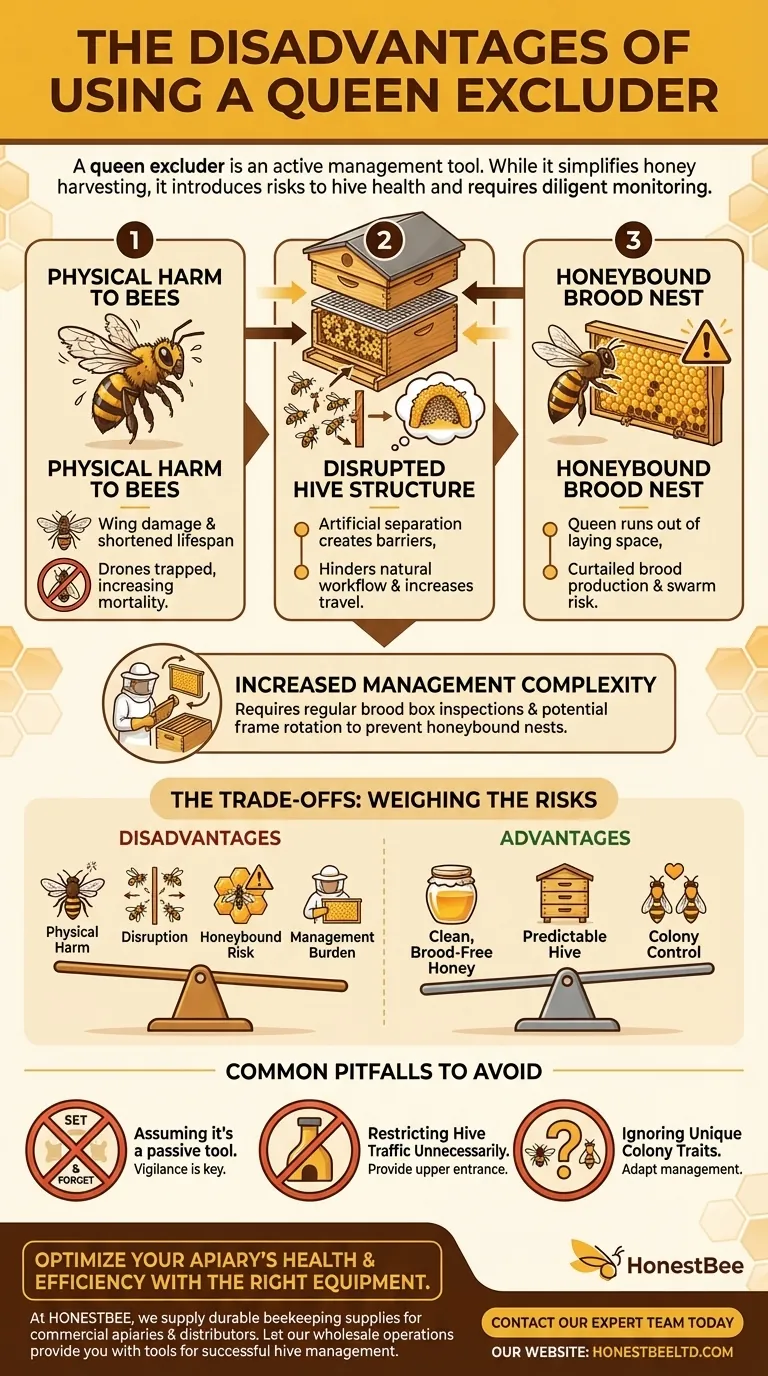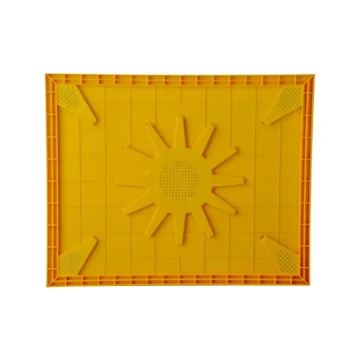In short, the main disadvantages of using a queen excluder are that it can physically harm bees, disrupt the natural hive structure, and create a "honeybound" brood nest that limits the queen's ability to lay eggs. These issues can increase the management burden on the beekeeper and potentially reduce the colony's overall productivity if not handled correctly.
A queen excluder is not a passive piece of equipment; it is an active management tool. While it simplifies honey harvesting, it introduces potential risks to hive health and requires diligent monitoring to prevent problems like a constrained queen and a congested brood chamber.

The Downsides of Separating the Hive
A queen excluder is a simple grid that worker bees can pass through but the larger queen and drones cannot. While this neatly separates the brood chamber from the honey supers, this forced division comes with notable costs.
Physical Harm to Bees
The most direct drawback is the physical toll on the colony. Drones, unable to fit, can get stuck and die in the excluder, and the constant passage through the sharp-edged grid can damage and fray the wings of worker bees over time, shortening their productive lifespan.
Disruption of Natural Hive Behavior
In a wild hive, there is no strict barrier between brood and honey. Bees often store honey around the brood nest in a natural arch. An excluder creates an artificial separation that can hinder the colony's efficiency and natural workflow, forcing bees to travel further and through a barrier to store nectar.
The Risk of a Honeybound Brood Nest
Perhaps the most significant risk is creating a honeybound brood chamber. As workers bring in nectar, they may fill empty cells in the brood box that the queen needs for laying eggs. Without the ability to expand upwards, the queen can run out of space, severely curtailing brood production and potentially triggering an early swarm.
Increased Management Complexity
Counterintuitively, using an excluder can demand more intervention, not less. To prevent the hive from becoming honeybound, the beekeeper must regularly inspect the brood box and potentially rotate frames, moving honey-filled frames out to give the queen more room to lay.
Understanding the Trade-offs
The decision to use an excluder is a classic beekeeping trade-off. The disadvantages must be weighed against a very compelling set of advantages, particularly for those focused on honey production.
The Primary Benefit: Clean, Brood-Free Honey
The main reason beekeepers use excluders is to guarantee that honey supers contain only honey. This prevents the queen from laying eggs in the frames you intend to harvest, resulting in cleaner honey, purer beeswax, and a much simpler extraction process without the risk of damaging brood.
The Management Advantage: A Predictable Hive
Excluders bring a level of order to the hive. They make finding the queen significantly easier, as her location is confined to the brood boxes below. This is a major time-saver for tasks like performing disease checks or re-queening a colony. For commercial operators, this efficiency is invaluable.
A Tool for Colony Control
Beyond honey, excluders are used for advanced hive management. They are essential for running two-queen systems, can be used in certain swarm prevention methods, and help control the overall size of the colony by dictating the size of the brood nest.
Common Pitfalls to Avoid
To use an excluder successfully, you must be aware of the common mistakes that amplify its disadvantages.
Assuming It's a "Set and Forget" Tool
The biggest error is adding an excluder and failing to monitor the brood box. Vigilance is required to ensure the queen always has adequate space to lay.
Restricting Hive Traffic Unnecessarily
The constant traffic through a single entrance and excluder causes a bottleneck and increases wear and tear on bee wings. Providing a small upper entrance in the honey supers can reduce this traffic, giving foraging bees a more direct route.
Ignoring Your Colony's Unique Traits
Not all colonies behave the same. Some are genetically predisposed to keep a tight, compact brood nest and will naturally keep the queen out of honey stores. Others, particularly certain wild or Africanized strains, are aggressive layers and may require an excluder to manage their expansion.
Making the Right Choice for Your Goal
Ultimately, the queen excluder is a tool with specific applications. Your beekeeping philosophy and goals should guide your decision.
- If your primary focus is commercial honey production: Using an excluder is often the standard practice, as its ability to ensure clean honey and save time outweighs the management overhead.
- If your primary focus is natural beekeeping: You will likely avoid the excluder to allow the colony to manage its own space, accepting that some honey frames may contain brood.
- If you are a new beekeeper: An excluder can make finding the queen easier, but you must be committed to inspecting the brood box to prevent it from becoming honeybound.
Deciding whether to use a queen excluder is about choosing which set of problems you would rather manage.
Summary Table:
| Disadvantage | Key Impact |
|---|---|
| Physical Harm to Bees | Wing damage, drone mortality, reduced worker lifespan |
| Disrupted Hive Behavior | Hindered natural workflow, forced travel through barrier |
| Honeybound Brood Nest | Queen runs out of laying space, potential for swarming |
| Increased Management | Requires frequent brood box inspections to prevent issues |
Optimize your apiary's health and efficiency with the right equipment. The decision to use a queen excluder involves careful management to avoid harming your colony's productivity. At HONESTBEE, we supply durable, beekeeping supplies and equipment designed for the needs of commercial apiaries and beekeeping equipment distributors. Let our wholesale-focused operations provide you with the tools for successful hive management. Contact our expert team today to discuss your specific needs and enhance your beekeeping operation.
Visual Guide

Related Products
- Professional Plastic Queen Excluder for Modern Beekeeping
- Wooden Queen Bee Excluder for Beekeeping
- Premium Wood Framed Metal Wire Queen Bee Excluder
- Metal Queen Bee Excluder for Beekeeping
- High Performance Plastic Queen Excluder for Beekeeping and Apiary Management
People Also Ask
- What are the pros of using queen excluders? Boost Honey Production & Hive Efficiency
- Why are queen excluders recommended for Flow Hives? Prevent Brood Damage for a Clean Harvest
- What is the primary function of a queen excluder in beekeeping? Control Hive Layout for Efficient Honey Harvesting
- What is the role of a queen excluder when adding a super? Ensure Brood-Free Honey Harvests
- How does a queen excluder work? Master Hive Management for Pure Honey Harvests



















